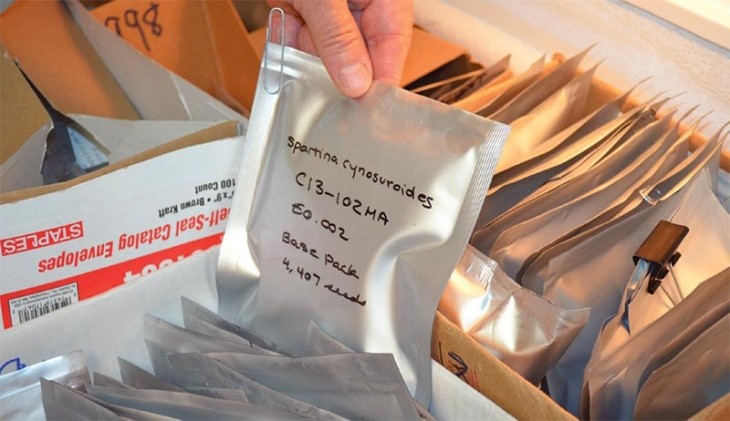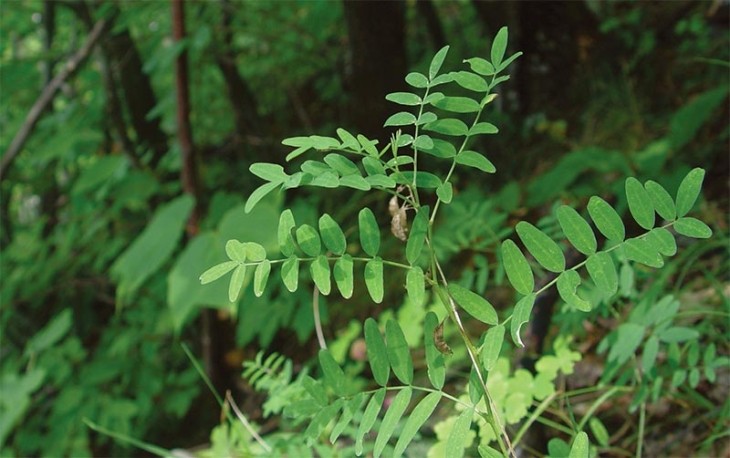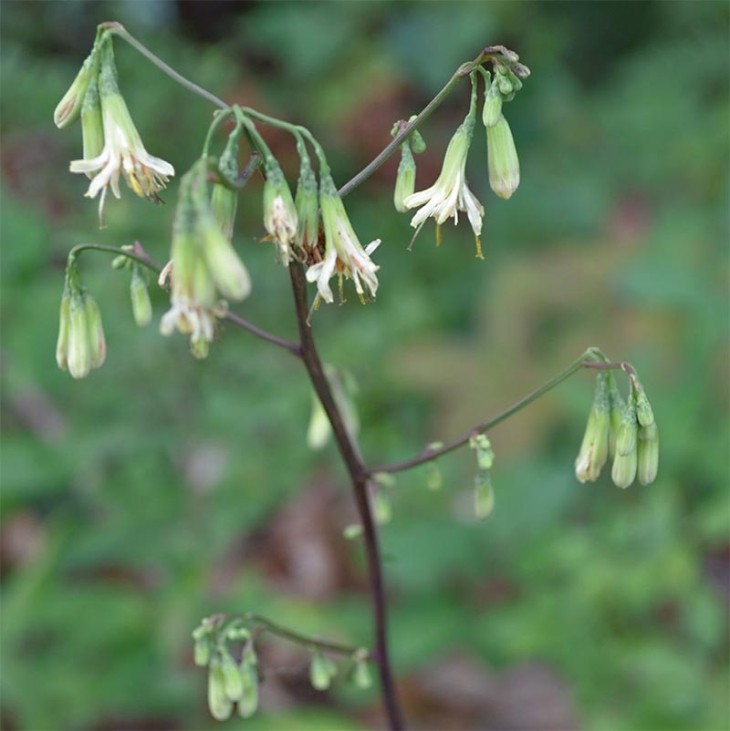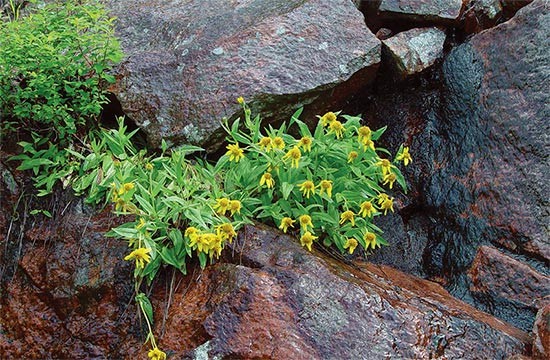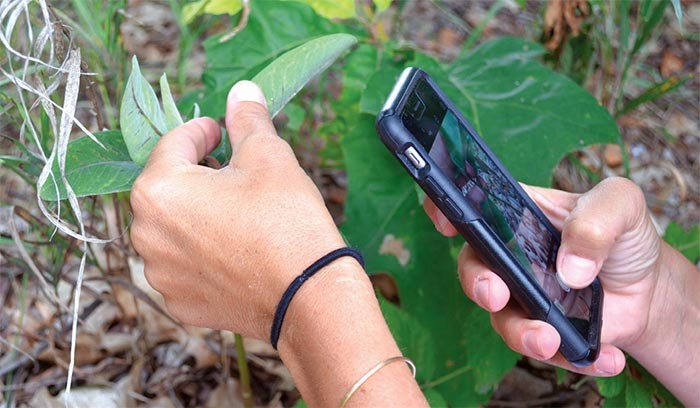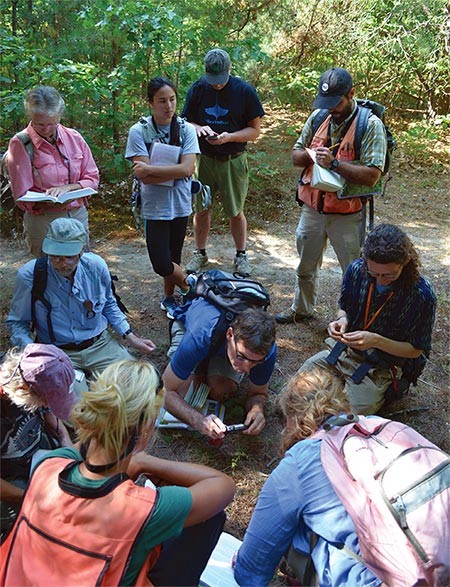
Carla Fenner strode along the railroad tracks outside Burlington, Vermont, on an August afternoon, wearing an orange surveyor’s vest and carrying a large volume entitled New Flora of Vermont, a manual for plant identification written by Arthur Gilman. Fenner was searching for the rare blunt-leaved milkweed (Asclepias amplexicaulis), known to exist in only a handful of locations in Vermont and distinct from our familiar common milkweed (Asclepias syriaca).
It seemed an improbable place to find a rare plant – railroad tracks bounded by a busy commercial road on one side and by suburban houses on the other. But the railroad right-of-way is a remnant of sandplain, a natural community that once covered a larger area of Chittenden County, and blunt-leaved milkweed prefers sandy soils. Historically, sandplains were kept open by fire; in this instance, mowing of the railroad corridor has mimicked the effects of fire to create favorable conditions for this rare plant.
Fenner scanned the banks on each side of the tracks. She examined the leaves of several milkweed plants growing in a grassy area. Just common milkweed, they did not have the wavy leaves with blunt ends and prominent tips characteristic of the rare species. Finally, Fenner spotted a couple of likely candidates. She opened her book, checked the criteria – success!
An environmental consultant and sometime wildfire fighter, Fenner’s work on this day was as a volunteer for the New England Wild Flower Society (NEWFS). Each year, 250 volunteers trained by NEWFS monitor rare plant populations identified by Natural Heritage Programs in the six New England states. These programs are part of an international network that gathers and provides information on the location and status of important ecological resources.
And the work is urgent. According to a technical report by NEWFS (State of New England’s Plants, published in 2015), 22 percent of New England’s native plant species are rare or have disappeared from the region. New England has 540 documented rare or historic plant species, including 62 species that are globally rare and 7 found nowhere else in the world. On average, rare plant species have lost 67 percent of their historic range in the region, and they are also rare in 38 percent of the states and provinces outside New England in which they occur.
Some plant species – such as alpine plants like mountain sandwort – are rare in New England because they have specific habitat requirements and our region simply has limited alpine habitat. Other species have declined due to myriad stressors acting synergistically, including development of their habitat, trampling, competition from invasive species, and succession. Some of the causes may be old: Many ecologists feel New England’s forests have not recovered from their clearing by early settlers and therefore are comprised of “depauperate flora.” Other threats loom on the horizon: A warming climate can lead to early flowering, making plants susceptible to spring frosts or causing them to lose sync with their pollinators. Global trade will lead to increases in diseases and insect pests.
Restoring Our Native Flora
Fortunately, people have banded together to protect and restore our native flora. The New England Plant Conservation Program, a partnership of government agencies, conservation organizations, universities, and professional botanists, was established in 1991. Under this umbrella, state task forces meet regularly to plan strategies for plant conservation.
Natural heritage programs in each state use a ranking system to determine whether a given species is rare in that state; a plant is given a number from one to five – ones denoting very rare and imperiled, fives denoting common and secure. Plants are also given a separate global rank. For example, the yellow lady’s slipper (Cypripedium parviflorum var. makasin) is ranked S1 in New Hampshire because it is known from five or fewer populations. This lady’s slipper is common in other parts of its range, so its global rank is G5, meaning it is secure globally. Hairy arnica (Arnica lanceolata), which has flowers resembling a yellow daisy, is ranked S2 – imperiled – in Maine. It is G3, or globally rare, with only 20 to 100 occurrences worldwide. In Maine, this arnica grows along the gravelly shores of the Saint John River and on wet cliffs on the sides of Mount Katahdin.
In general, populations of rare plants have been identified and mapped over the years through extensive fieldwork and the use of historical data such as dried herbarium specimens, records of witness trees in early land deeds, soil cores, and even writings and paintings by early naturalists and artists. But there are still new findings. Bill Nichols, state botanist with the New Hampshire Natural Heritage Bureau, recalled the discovery of a grass previously unknown in the state by a volunteer in a university herbarium; the state listed it as endangered. Nichols said New Hampshire updates its rare plant list every five years because of new information and changes in plant taxonomy arising from DNA analysis. Some plants considered separate species are now lumped together; other species have been split apart.
Jesup’s milk-vetch (Astragalus robbinsii var. jesupii) is one beneficiary of these conservation efforts. A member of the legume family with delicate compound leaves and flowers ranging from white to purple, it grows on rock ledges along rivers. There are only three known populations of this perennial remaining in the world, all found in the Connecticut River Valley along the border between Vermont and New Hampshire. A federal and state endangered species, Jesup’s milk-vetch needs the scouring by chunks of ice floating downstream in spring to maintain open rock ledges. According to Bob Popp, botanist with the Vermont Fish and Wildlife Department’s Natural Heritage Inventory, there may be less ice scour now because dams have changed the Connecticut River’s hydrology. Another factor contributing to the decline of this plant is competition from poison ivy and various non-native plants.
Popp was part of a group representing Vermont, New Hampshire, and the New England Wild Flower Society that recently established a new population of Jesup’s milk-vetch upriver of the existing populations and above the dams. First, they collected seeds from wild plants; NEWFS grew plants from these seeds at its botanical facility, Garden in the Woods. Popp and others transplanted the seedlings to the river shore location and then augmented this population with more transplants for three years. In coming years, the newly established plants will be protected from competition by the use of herbicide to control invasives and by the removal of vegetation on the bank above.
Aaron Marcus, assistant botanist with the Vermont Department of Fish and Wildlife, has been working to protect and restore another globally rare plant: Wright’s spike-rush (Eleocharis diandra), a small sedge that grows in clumps on sandy shores. Its slender, soft, reclining stems are topped by plump balls of seeds.
There are fewer than 30 known populations of Wright’s spike-rush in the world, most of them in Vermont, where it grows along the Connecticut River and Lake Champlain. The plant also grows farther south on the Connecticut River and on the Androscoggin and Merrimack Rivers in Maine and New Hampshire. The challenge, observes Marcus, is that beaches are popular recreational areas. On one busy beach in Burlington, for example, the spike-rush now occurs only in the least-trampled spots. “We need to find ways to allow these plants to coexist with people,” he said. Marcus has been working with Burlington Parks, Recreation & Waterfront to reduce trampling at this beach. They have erected signs, distributed educational flyers, and are working to change maintenance practices to leave logs and leaf litter at one end of the beach, making it less attractive to people.
Not all rare plants benefit from being left alone. The small whorled pogonia (Isotria medeoloides) is a globally rare orchid revered by orchid enthusiasts. Most of the world’s population grows in the thick leaf litter of mixed deciduous and coniferous forests in Maine and New Hampshire. An unusual-looking plant, one or two greenish-yellow flowers rise above a whorl of five leaves attached at the same point on the stem. Bill Brumback, conservation director at NEWFS, recalled that after a utility company trimmed trees at one site where this orchid grows, the number of plants increased. He suspected these orchids might be an earlier successional species that needed more light to thrive. NEWFS partnered with the New Hampshire Natural Heritage Bureau to perform an experiment at another site where the small whorled pogonia grows. Taking care to work in the winter when the ground was frozen, they thinned the forest canopy over half the site, removing all the shrubs and 25 percent of tree basal area, doubling the amount of light reaching the ground. The canopy was left intact over the remainder of the site as a control. The number of orchids significantly increased in the more open area, and reproductive success improved. Brumback postulated that more sunlight may also have helped the mycorrhizal fungi that orchid seedlings depend on for nutrients. This strategy is now being used to manage other sites where this orchid grows.
Seed Banking
Efforts are underway not just to protect rare plants in natural settings, but also to preserve the genetic record of these plants. A small wooden building behind NEWFS headquarters in Framingham, Massachusetts, houses a chest freezer containing cardboard boxes organized by year that contain foil packets neatly labelled with plant species’ names and locations. This is a seed bank containing seeds from 200 species of rare plants in New England, drawn from more than 500 different populations. By collecting seeds from several populations, the goal is to “capture the genetic diversity of each species,” explained Brumback. NEWFS’s plan is to store seeds from 300 globally or regionally rare species in this fireproof, insulated building, both for use in restoration efforts and as a hedge against extinction.
The seeds are collected, counted, and cleaned by volunteers and staff. Next, they are placed in a specialized drying room at the Society’s Nasami Farm facility to “try to slow down metabolism – they’re living things,” said Brumback. Once dried to 15- to 20-percent moisture content, the seeds are placed in heat-sealed foil packets and then frozen. The freezer is maintained at a temperature of zero degrees Fahrenheit. Most New England plant species have seeds that can withstand the drying and freezing needed for long-term storage, and the seeds will last for 50 to 100 years. (NEWFS has germinated seeds that are over 20 years old.) Brumback plans to broaden the seed bank to include common species so that local genotypes are available for restoration projects.
Seeds of New England’s rare and common species have also been sent to the Millenium Seed Bank at Kew Gardens, England, which aims to save 25 percent of the world’s bankable seeds by 2020.
Why Save Them?
Why go to this trouble to save all of New England’s plants, some inconspicuous and not serving any apparent purpose? “One reason we focus on plants is that we end up conserving entire ecosystems, including things we can’t see, such as underground fungi, which are really important to forests,” said Aaron Marcus. “Plants act as canaries in the coal mine. Their decline can indicate other changes in the landscape, such as the loss of pollinators. Ecosystems are complex. We don’t always know what we’re losing when we lose these species.” He recalled the famous Aldo Leopold quote: “To keep every cog and wheel is the first precaution of intelligent tinkering.” Marcus said, “Biodiversity is going to be important in the resilience of our ecosystems to climate change and to human survival.”
Bob Popp adds that rare species are part of our states’ natural heritage. Most of the rare plants in Vermont are not globally rare, he said, but it is important to conserve them in the state because species at the edge of their range are often more genetically diverse. “That’s where evolution occurs. They may evolve into different species over thousands of years.” This will be important as plant species need to shift ranges and evolve in response to climate change.
“I think these species have as much right to live here as we do,” declared Bill Brumback.
Back outside Burlington, Carla Fenner continued along the railroad tracks, searching for additional rare plants. Suddenly, a tall, spindly plant with drooping, cream-colored flowers and protruding yellow stamens caught her eye. After checking her book to make sure, Fenner confirmed it was three-leaved rattlesnake-root (Nabalus trifoliolatus), a member of the Asteraceae family and another uncommon sandplain denizen, ranked S3 in Vermont. Before today it was not known from this location. Her face lit up – what a find!


